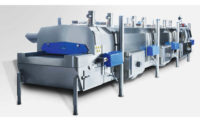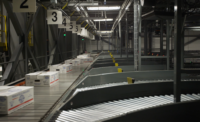Poultry processors turn to cryogenic mixer-chilling to lift efficiencies

 With the U.S. consuming more chicken than ever – estimated to rise more than 2 percent to 86.6 lbs. per person a year in 2015 – poultry processors are eager to improve efficiencies. Ready-to-cook poultry production topped more than 4.15 billion pounds in October, up 2 percent from 2013, and much is processed into formed product.
With the U.S. consuming more chicken than ever – estimated to rise more than 2 percent to 86.6 lbs. per person a year in 2015 – poultry processors are eager to improve efficiencies. Ready-to-cook poultry production topped more than 4.15 billion pounds in October, up 2 percent from 2013, and much is processed into formed product.
“Small improvements in processing efficiencies for formed poultry can mean millions of dollars on the bottom line across an entire operation,” says Mark DiMaggio, Head of Food & Beverage, Linde LLC.
Cryogenic bottom-injection (BI) chilling systems – precisely engineered to poultry mixers -- can help ensure consistent product quality, repeatable mixing and forming operations, and increase line production. “Even mixer-chilling systems installed just a few years ago can potentially benefit from the latest technology and custom engineering,” he said.
Advanced ACCU-CHILL Bottom-Injection Chilling Systems from Linde, which can use either liquid carbon dioxide (CO2) or liquid nitrogen (N2), utilize the cryogen more efficiently and rapidly than conventional systems. The patented system chills ground, formed or case-ready proteins from the bottom of mixers/blenders with cryogenic efficiency – and precision. Temperature can be controlled within ±1.0ºF.
Poultry Upshift
One major poultry processor has leveraged Linde BI technology (and technical upgrades) for more than 20 years, and now chills millions of pounds of formed poultry a month for the fast-food market. Formed items include fillets, patties, tenders, and nuggets.
Bottom-injection chilling systems are already widely used in beef processing, where 60 percent of U.S. production is for ground product. Interstate Meat Distributors Inc. (Clackamas, OR), for example, reduced cycle times by 50 percent with a new ACCU-CHILL BI system in 2011 that replaced existing components with specialized proprietary equipment.
DiMaggio points out, however that, cryogenic BI mixer-chilling technology is now making a strong upshift in the poultry industry. “Top poultry processors are now employing the new technology on their lines, and we see it starting to predominate because a new system can make such a dramatic impact.” He emphasizes that for either ground beef or poultry mixers, “injector system design and engineering are paramount to maximize process efficiencies.”
The Linde food team can retrofit the ACCU-CHILL BI system to existing mixers, or design and install a customized chilling system when upgrading to new mixing or grinding equipment. Easy installation, operation and proprietary hygienic nozzle design contribute to the effectiveness and efficiency of the Advanced ACCU-CHILL BI system. Besides accuracy, repeatability and high-quality results, higher efficiency can help processors reduce operating costs and achieve higher production capacities, or achieve the same capacity with reduced labor.
ACCU-CHILL BI chilling systems are inherently more efficient than top-injected systems that typically use CO2 snow. In fact, top-chilling may require three times more processing time and 20-25% more cryogen to achieve the same desired temperature. With a top-chilled mixer, CO2 snow loses refrigeration as it travels through the air from the top of the mixer, and more BTUs are lost to the mixer exhaust before the CO2 snow is blended into the meat. In contrast, injecting a liquid cryogen from the bottom of the mixer/blender utilizes most of the refrigeration available because it is immediately available to the chilling process.
The Linde food team performs in-plant assessments and works with food processors to develop optimal solutions. For more information, visit Linde (www.lindefood.com) or call: 800-755-9277.
Linde LLC supports the Global Food Safety Initiative (GFSI) and the advancement of food safety. Linde has a Food Safety Management System in place for all bulk carbon dioxide (CO2) plants and air separation facilities supplying the food & beverage industry in North America. In June 2012, Linde became the first supplier to certify all of its CO2 plants to a benchmarked GFSI scheme, FSSC 22000 (Food Safety System Certification).
Looking for a reprint of this article?
From high-res PDFs to custom plaques, order your copy today!





